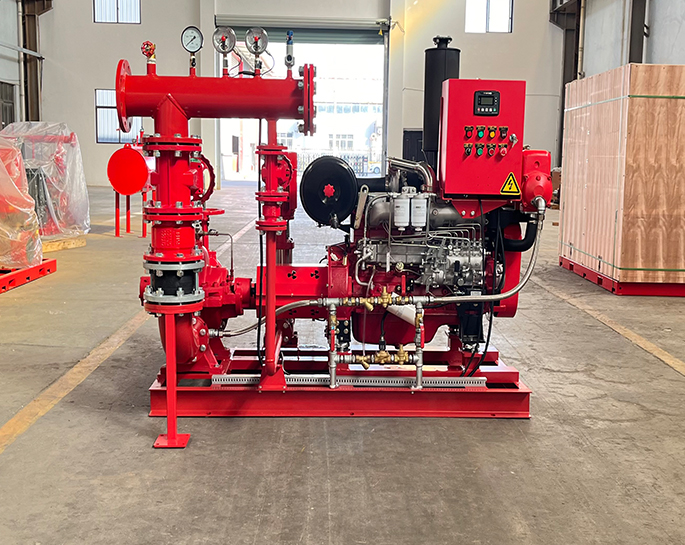What role do fire pump pressure gauges play, and how are they calibrated?
Jan 04, 2024
Share:
Fire pump pressure gauges play a crucial role in monitoring and ensuring the proper functioning of fire pump systems. These gauges provide real-time information about the pressure levels within the system, allowing operators and maintenance personnel to verify that the pump is operating within the desired range. Here's an overview of their role and how they are calibrated:
### Role of Fire Pump Pressure Gauges:
1. **Pressure Monitoring:**
Fire pump pressure gauges continuously display the pressure levels in the pump system, including suction and discharge pressures. Monitoring these pressures is essential for ensuring that the pump is providing an adequate flow of water to the fire protection system.
2. **Troubleshooting:**
Pressure gauges help identify issues within the fire pump system. Sudden drops or fluctuations in pressure may indicate problems such as leaks, blockages, or pump malfunctions. This information aids in timely troubleshooting and maintenance.
3. **Compliance Verification:**
Regular monitoring of pressure levels is necessary to ensure that the fire pump system complies with the design specifications, industry standards, and regulatory requirements.
### Calibration of Fire Pump Pressure Gauges:
Calibration is the process of adjusting and verifying the accuracy of a pressure gauge. Proper calibration is crucial to ensure that the readings provided by the gauge are reliable. Here are the steps typically involved in calibrating fire pump pressure gauges:
1. **Frequency of Calibration:**
Fire pump pressure gauges should be calibrated at regular intervals, typically as part of routine maintenance or testing procedures. The frequency may vary based on industry standards, manufacturer recommendations, and local regulations.
2. **Selecting Calibration Equipment:**
Calibration is performed using specialized calibration equipment that provides known and traceable pressure standards. This equipment should be regularly checked and certified for accuracy.
3. **Isolation from the System:**
Before calibration, the pressure gauge should be isolated from the system to ensure that the calibration process does not interfere with the actual operating conditions of the fire pump.
4. **Adjustment or Replacement:**
If the pressure gauge deviates from the acceptable tolerance limits during calibration, adjustments may be made to bring it back into alignment. In some cases, if the gauge cannot be adjusted, it may need to be replaced.
5. **Documentation:**
Calibration activities should be documented, including the date of calibration, the technician performing the calibration, any adjustments made, and the results. This documentation is important for maintaining a record of the gauge's accuracy over time.
6. **Certification:**
Once calibrated, the pressure gauge should be certified as accurate. Certification provides assurance that the gauge meets the required standards and can be relied upon for accurate pressure readings.
Calibration should be conducted by trained and qualified personnel to ensure accuracy and compliance with applicable standards and regulations. Regular calibration helps maintain the reliability of fire pump pressure gauges and contributes to the overall effectiveness of fire protection systems.

### Role of Fire Pump Pressure Gauges:
1. **Pressure Monitoring:**
Fire pump pressure gauges continuously display the pressure levels in the pump system, including suction and discharge pressures. Monitoring these pressures is essential for ensuring that the pump is providing an adequate flow of water to the fire protection system.
2. **Troubleshooting:**
Pressure gauges help identify issues within the fire pump system. Sudden drops or fluctuations in pressure may indicate problems such as leaks, blockages, or pump malfunctions. This information aids in timely troubleshooting and maintenance.
3. **Compliance Verification:**
Regular monitoring of pressure levels is necessary to ensure that the fire pump system complies with the design specifications, industry standards, and regulatory requirements.
### Calibration of Fire Pump Pressure Gauges:
Calibration is the process of adjusting and verifying the accuracy of a pressure gauge. Proper calibration is crucial to ensure that the readings provided by the gauge are reliable. Here are the steps typically involved in calibrating fire pump pressure gauges:
1. **Frequency of Calibration:**
Fire pump pressure gauges should be calibrated at regular intervals, typically as part of routine maintenance or testing procedures. The frequency may vary based on industry standards, manufacturer recommendations, and local regulations.
2. **Selecting Calibration Equipment:**
Calibration is performed using specialized calibration equipment that provides known and traceable pressure standards. This equipment should be regularly checked and certified for accuracy.
3. **Isolation from the System:**
Before calibration, the pressure gauge should be isolated from the system to ensure that the calibration process does not interfere with the actual operating conditions of the fire pump.
4. **Adjustment or Replacement:**
If the pressure gauge deviates from the acceptable tolerance limits during calibration, adjustments may be made to bring it back into alignment. In some cases, if the gauge cannot be adjusted, it may need to be replaced.
5. **Documentation:**
Calibration activities should be documented, including the date of calibration, the technician performing the calibration, any adjustments made, and the results. This documentation is important for maintaining a record of the gauge's accuracy over time.
6. **Certification:**
Once calibrated, the pressure gauge should be certified as accurate. Certification provides assurance that the gauge meets the required standards and can be relied upon for accurate pressure readings.
Calibration should be conducted by trained and qualified personnel to ensure accuracy and compliance with applicable standards and regulations. Regular calibration helps maintain the reliability of fire pump pressure gauges and contributes to the overall effectiveness of fire protection systems.


.png)
.png)

.png)


